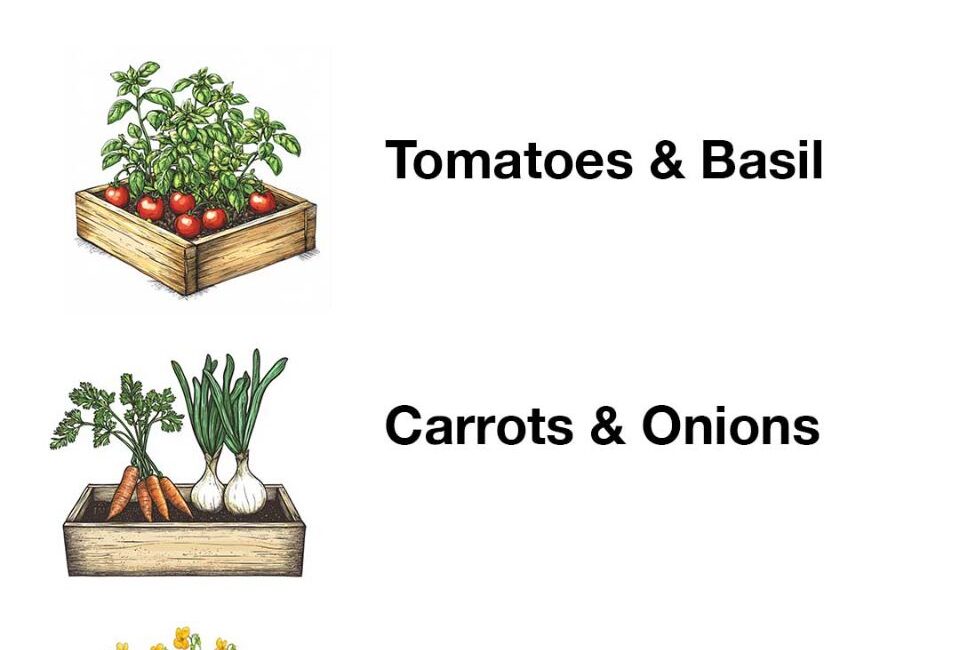Companion planting is an age-old gardening technique where specific plants are grown together to enhance growth, repel pests, improve soil health, and maximize yields. When gardening in raised beds, strategic companion planting becomes even more beneficial, as space is limited and efficiency is key.
In this guide, we explore 12 essential companion planting combinations that work exceptionally well in raised beds, helping you create a productive and harmonious garden.
1. Tomatoes & Basil 🌿🍅
Why They Work Together:
- Basil repels tomato pests like aphids, whiteflies, and hornworms.
- Enhances tomato flavor when grown nearby.
- Improves growth and yield of tomatoes.
Planting Tips:
- Plant basil between tomato plants to provide pest control benefits.
- Keep tomato plants staked or caged to prevent shading out basil.
- Avoid planting with cabbage, as they compete for nutrients.
2. Carrots & Onions 🥕🧅
Why They Work Together:
- Onions repel carrot flies and other pests.
- Carrots help aerate the soil, benefiting onion roots.
- Both have different root depths, minimizing competition.
Planting Tips:
- Plant onion bulbs between rows of carrots.
- Use succession planting for a continuous harvest.
- Avoid planting with dill, which can stunt carrot growth.
3. Cucumbers & Nasturtiums 🥒🌸
Why They Work Together:
- Nasturtiums act as a trap crop, attracting aphids away from cucumbers.
- Repel squash bugs, cucumber beetles, and whiteflies.
- Encourage pollinators, improving fruit production.
Planting Tips:
- Plant nasturtiums around the edges of raised beds.
- Allow cucumbers to climb a trellis to save space.
- Keep away from potatoes, as they stunt cucumber growth.
4. Peppers & Marigolds 🌶️🌼
Why They Work Together:
- Marigolds deter aphids, nematodes, and beetles that attack pepper plants.
- Marigold roots release a natural pesticide into the soil.
- Attract beneficial insects like ladybugs and hoverflies.
Planting Tips:
- Interplant marigolds around the perimeter of your pepper bed.
- Use French marigolds, as they offer the best pest control.
- Avoid planting peppers near beans, which can stunt their growth.
5. Corn, Beans & Squash (Three Sisters Method) 🌽🫘🎃
Why They Work Together:
- Corn provides natural support for beans to climb.
- Beans fix nitrogen in the soil, feeding the corn and squash.
- Squash leaves shade the soil, reducing weeds and retaining moisture.
Planting Tips:
- Plant corn first, then beans, then squash a few weeks later.
- Space plants to allow good air circulation and prevent fungal issues.
- Avoid planting near potatoes, as they compete for nutrients.
6. Lettuce & Radishes 🥬🌱
Why They Work Together:
- Radishes grow quickly, loosening the soil for lettuce roots.
- Repel leaf-eating insects that target lettuce.
- Maximize space, as radishes grow deep while lettuce stays shallow.
Planting Tips:
- Plant radishes first, followed by lettuce a few weeks later.
- Harvest radishes before they shade the lettuce.
- Keep soil consistently moist for best results.
7. Cabbage & Dill 🥬🌿
Why They Work Together:
- Dill attracts predatory wasps, which eat cabbage worms.
- Enhances growth of cabbage by repelling pests.
- Improves flavor when grown together.
Planting Tips:
- Plant dill near cabbage but not near carrots (it stunts their growth).
- Harvest dill leaves regularly to prevent it from overshadowing cabbage.
- Keep beds weed-free to avoid competition.
8. Strawberries & Thyme 🍓🌿
Why They Work Together:
- Thyme repels aphids, slugs, and worms that damage strawberries.
- Improves soil structure and drainage.
- Enhances strawberry flavor and yield.
Planting Tips:
- Interplant thyme around strawberry borders for maximum benefits.
- Avoid planting strawberries near cabbage, as they compete for nutrients.
- Mulch with straw to retain moisture.
9. Spinach & Garlic 🌱🧄
Why They Work Together:
- Garlic repels aphids and spider mites, which attack spinach.
- Improves disease resistance in spinach plants.
- Uses vertical space efficiently, as garlic grows tall while spinach stays low.
Planting Tips:
- Plant garlic in rows around spinach beds.
- Water spinach consistently to prevent bitterness.
- Avoid planting garlic near beans or peas.
10. Beets & Swiss Chard ❤️🥬
Why They Work Together:
- Similar water and nutrient needs, making them ideal companions.
- Swiss chard provides shade, helping beets retain moisture.
- Both attract pollinators, increasing yield.
Planting Tips:
- Space beets 2 inches apart to prevent crowding.
- Mulch to maintain soil moisture.
- Avoid planting with pole beans, as they stunt beet growth.
11. Broccoli & Calendula 🥦🌼
Why They Work Together:
- Calendula attracts pollinators and beneficial insects that control cabbage pests.
- Enhances soil health by repelling root nematodes.
- Broccoli benefits from shade, reducing bolting in hot weather.
Planting Tips:
- Interplant calendula between broccoli rows.
- Keep soil rich in organic matter for best growth.
- Avoid planting with strawberries, as they compete for nutrients.
12. Potatoes & Horseradish 🥔🌿
Why They Work Together:
- Horseradish repels Colorado potato beetles and aphids.
- Improves disease resistance in potatoes.
- Does not compete for nutrients, as horseradish roots grow deep.
Planting Tips:
- Plant horseradish around potato beds as a border plant.
- Harvest horseradish in fall for best flavor.
- Avoid planting potatoes near tomatoes, as they attract the same pests.
Final Thoughts
Companion planting in raised beds offers natural pest control, improved soil health, and higher yields. By using these 12 essential plant combinations, you can create a thriving, productive garden that minimizes problems and maximizes harvests.



